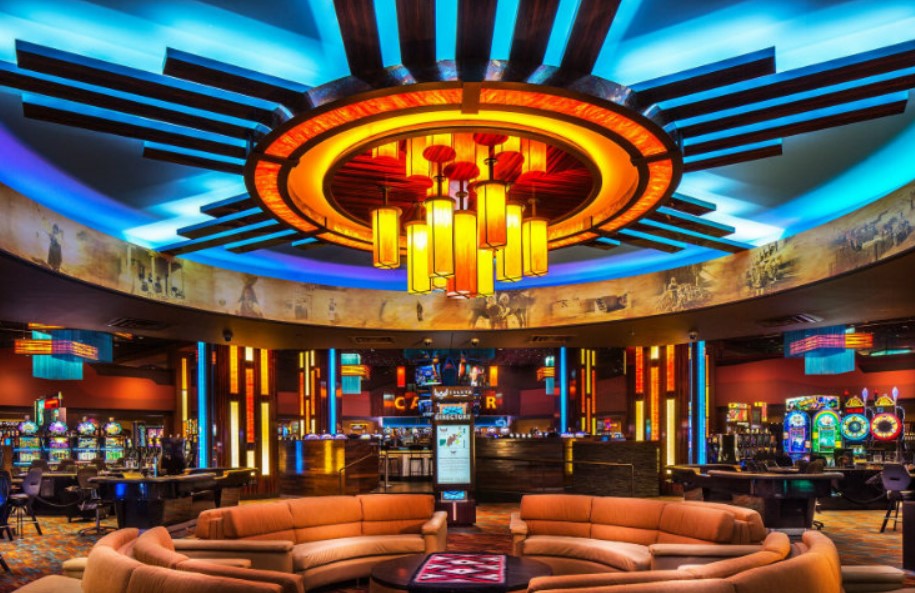
Casinos are known for their vibrant atmosphere, where players immerse themselves in a world of entertainment and gambling
Behind the glitz and glamour lies a meticulously crafted environment designed to captivate visitors and enhance their gaming experience. This article explores the fascinating realm of casino design and the psychology behind it, uncovering the strategies employed to create an atmosphere of excitement, engagement, and prolonged player activity
1. Layout and Flow:
Casino design aims to create a seamless flow that entices players to explore the various gaming areas. Casinos strategically arrange gaming floors, slot machines, and table games to optimize player traffic and encourage movement throughout the space. The layout often features open spaces, curved pathways, and visually appealing focal points that guide players from one area to another, ensuring they encounter a wide range of gaming options.
2. Colors and Lighting:
Color psychology plays a crucial role in casino design, with carefully selected hues creating specific moods and atmospheres. Bold and vibrant colors, such as reds and golds, are often used to evoke excitement, energy, and a sense of opulence. Lighting design is equally significant, with a balance between ambient, task, and accent lighting. The right lighting enhances the gaming experience, creates focal points, and sets the desired ambiance for different areas within the casino.
3. Soundscapes and Music:
Casinos are known for their unique soundscapes, carefully crafted to enhance the gaming atmosphere. Pleasant background music, often featuring upbeat and energetic tunes, creates a sense of excitement and encourages players to stay engaged. Slot machines are designed to emit melodic sounds and celebratory noises, triggering a Pavlovian response in players. The careful selection and manipulation of sound contribute to the overall immersive experience within the casino.
4. Slot Machine Placement:
Slot machines, a staple of any casino, are strategically placed to maximize player engagement. High-traffic areas and entrance points often feature clusters of slot machines, enticing players with visual and auditory stimuli. The “clustering” effect creates a sense of activity and excitement, while strategically positioning high-payout machines near walkways and dining areas increases their visibility and appeal.
5. Table Game Arrangement:
Table games, such as blackjack and roulette, are carefully arranged to create an intimate and social atmosphere. The layout facilitates interaction between players and the dealer, fostering a sense of camaraderie and shared excitement. Table games are often placed in central areas, visible from various vantage points, to generate interest and attract new players.
6. Architecture and Interior Design:
Casino architecture and interior design play significant roles in shaping the overall experience. Lavish and grandiose architectural elements, such as domed ceilings, ornate chandeliers, and intricate details, contribute to the sense of luxury and opulence. Interior design elements, such as plush furnishings, comfortable seating, and elegant decor, create a welcoming and indulgent ambiance that encourages players to stay and engage in gaming activities.
7. Psychological Triggers:
Casino design incorporates psychological triggers to enhance player engagement. By utilizing principles such as operant conditioning, variable rewards, and sensory stimulation, casinos create an environment that keeps players coming back for more. Frequent rewards, whether through small payouts or complimentary services, reinforce the pleasure-seeking behavior of players and contribute to prolonged engagement.
8. Accessibility to Amenities:
Casinos strategically provide easy access to amenities such as restaurants, bars, and entertainment venues. This design choice ensures that players have convenient options for relaxation, socialization, and refreshments. Accessible amenities create a comprehensive entertainment experience, allowing players to take breaks and engage in non-gambling activities while remaining within the casino environment.
Conclusion:
Casino design and psychology are intricately intertwined, shaping the atmosphere and experience for players. The layout, colors, lighting, soundscapes, and architecture work together to create an engaging and exciting environment that encourages prolonged player activity. Understanding the principles behind casino design enhances our appreciation of the thought and strategy that goes into crafting these captivating spaces.


